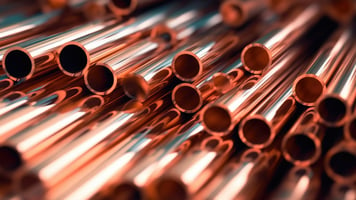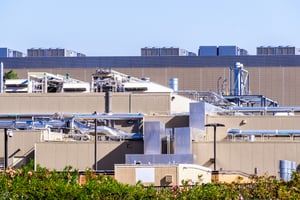A Comparative Study of Small-Diameter Copper Tubes with LU-VE With growing concerns about...
Heat Pumps and Small-Diameter Copper Tube: The Future of Heating and Cooling
As the HVAC/R industry shifts away from fossil fuels and towards materials with increased energy efficiency and less environmental impact, emerging vapor compression cycle (VCC) applications can popularize heat pumps as an alternative heating method to fossil fuels and electrical resistance heating.
The VCC works by passing a cooled refrigerant through an expansion valve, which picks up heat as it expands through the outdoor unit (ODU). Then, a compressor adds work energy as it compresses and condenses the refrigerant, releasing heat gained through the indoor unit (IDU). The heat output depends on multiple factors, including the outdoor and indoor ambient temperatures as well as the efficiencies of the coils.
The advantages of including copper tubing in heat pumps include heat outputs many times greater than the work input. Small-diameter, inner-grooved copper tubes conduct heat better, shed water quickly, and require less refrigerant. These are extremely important for manufacturers seeking to design more energy-efficient appliances.

Utilizing heat pumps can also alleviate dependence on hydrocarbon-powered equipment and appliances, as heat pumps are compatible with clean, renewable energies such as solar, wind, and geothermal.
This article will explore how inner-grooved, small-diameter copper tubes make heat pumps more efficient, focusing on increased heating output, cost reduction, and environmental impacts.
For a comprehensive overview, read this paper titled Small-Diameter Copper Tubes Make Heat Pumps More Efficient by the Copper Development Association. The article covers VCC and New Heat Pump Designs.
What are the Advantages of Enhanced, Small-Diameter Copper Tubes?
- Require Less Refrigerant Charge
- Better heat conductors due to a larger internal surface area
- Resistant to corrosion

Small-Diameter Copper Tubes Require Less Refrigerant Charge
New designs of heat pumps promise better management of temperature and thermal energy in homes as well as commercial and industrial applications. Environmentally friendly refrigerants, high-technology compressors, and smart expansion valves provide unprecedented control over the refrigeration cycle.
One of the most significant benefits of inner-grooved, small-diameter copper tubes in heat pumps is that they require less copper and less refrigerant charge due to the smaller internal volume of the coils.
The environmental impacts of the HVAC/R industry are widely debated. As a result, industry leaders advocate for the use of low global warming potential (GWP) natural refrigerants such as hydrocarbons (R290 and R600a), carbon dioxide (R744), and ammonia (R717). The need for less refrigerant provides a cost, design, and environmental advantage when applying new, low GWP refrigerants like R-290 (i.e., propane) to small-diameter copper tubes.
Small-Diameter Copper’s Inner-Grooves Conduct Heat Better
Smaller-diameter, inner-grooved copper tube evaporators efficiently gather energy from indoor spaces, waste, heat, or outdoor heat sources. On the other side of the refrigeration cycle, these condensers and gas coolers offer outstanding performance for heating indoor spaces and hot water.
The inner grooving of small-diameter copper tubes increases the internal surface area, making heat transfer more effective due to more tubing coming in contact with the refrigerant. In conjunction with reducing the amount of copper needed, small-diameter copper tubes lead to energy efficiencies in HVAC/R equipment and manufacturing.
Additional advantages can be obtained using smaller-diameter, inner-grooved copper tubes to build highly efficient, round-tube plate fin (RTPF) coils for refrigerant-to-air heat exchangers, including evaporators, condensers, and gas coolers.
Small-Diameter Copper Tubes are Corrosion Resistant
Due to its anti-microbial and corrosion-resistant nature, copper coils and small-diameter tubing are incredibly durable. As a result, copper tubes can last many years without needing a replacement, significantly reducing maintenance and servicing costs.
Corrosion resistance is significant for Air-to-Air (ATP) and Air-to-Water (ATW) applications used for residential central air conditioners. For ATP and ATW units, the condenser and evaporator benefit from copper’s ability to quickly shed the condensate from the evaporator.
Applications of Small-Diameter Copper Tubing in Heat Pumps

(Courtesy of LU-VE Spirotech)
The smaller-diameter, inner-grooved copper tubes conduct heat better, shed water quickly, and require less refrigerant. All this adds up to more efficient and more compact heat pumps.
However, one must ask what the practical applications of copper tubing in heat pump technology would look like.
1. Reduce the cost of ground-source heating pumps.
Ground Source Heat Pumps (GSHPs) were lauded for their ability to perform even in colder climates since they take advantage of the naturally occurring temperature differential between above-ground air and soil below the frost line. GSHPs are used in heating and cooling for typical residential applications such as air conditioning. However, high costs and the impracticalities of underground heat exchangers have cooled enthusiasm for this heat pump application.
GSHPs work by circulating a heat carrier fluid through the underground piping system; this is then absorbed and used in the heat exchange by the above-ground heating pump. Introducing small-diameter copper tubing would address the main pain points of cost and reliability, as utilizing smaller-diameter copper tubes in heat pump condenser designs also makes it possible to achieve more efficient use of space within the system, which in turn means savings on materials.
Copper tubing is also known for its exceptional durability and longevity. It can withstand harsh environmental conditions, resist corrosion, and maintain its performance over an extended period. This longevity ensures that HVAC/R equipment with copper tubes experiences fewer failures and requires fewer replacements.
2. Increase energy efficiency for hot water heating systems.
Heat Pump Water Heaters (HPWHs) obtain heat from the ground or air for space heating or domestic hot water. The heat is transferred to the water through a condenser coil, which is then transferred to radiators, baseboard heaters, or by pumping hot water through a network of pipes in the wall or floor. Small-diameter copper tubing application here could increase heating output due to the larger surface area the inner grooves allow.
In conclusion, small-diameter, inner-grooved copper tubes have many applications within heat pump technology. As more concerns are placed on the environmental impacts of inputs, manufacturers will need innovative heating applications that make environmental goals financially beneficial without sacrificing performance and durability.
The properties of copper tubing yield a product that uses less material and energy to create more heating output than competing materials. In conjunction with the cost-saving and sustainability benefits, copper tubing in heat pump applications could significantly shift the industry away from fossil fuel as a primary heating source.
To learn more about small-diameter copper tubing in heat pump technology, watch our webinar titled Case Study: A Cold Climate Air Source Split Heat Pump Water Heater, presented by Yoram Shabtay, President of Heat Transfer Technologies.
For more information on how small-diameter copper tubes improve heat pump efficiency in various ways, contact the Copper Development Association.


.png?height=200&name=CDA%20%20Zoom%20Invitation%20Page%20Banner%20(1).png)
